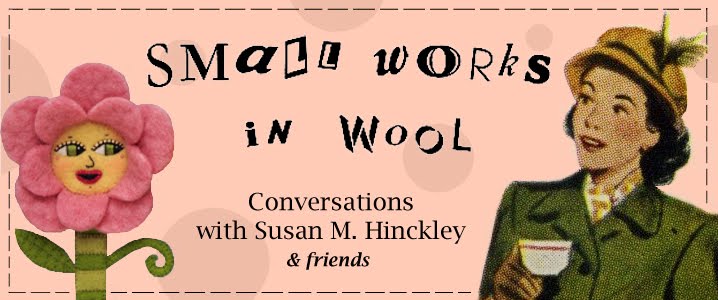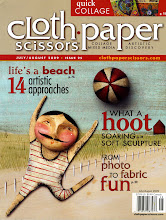All this talk of mythology and embroidery . . .
(see Monday's post)
[and thanks again, Mr. Yeats, for your exquisite word-image which I can't get out of my mind]
reminded me that I have yet to finish our book tour of this book:

which I first shared with you in a previous T.G.I.F.F.T.
One of the things that sets this book apart is the way it showcases contemporary embroidery (which we looked at last time) as well as historical embroidery, and then draws parallels between the two.
If you ever want to feel part of something much bigger than yourself (and if you're prone to sitting and stitch-stitch-stitching thousands of tiny and insignificant lines, as I am) take a look at embroidery throughout history.
It is an art that truly cuts across both time and culture.
And when we embroider, whether for the sake of art or embellishment, we're participating in a tradition so rich in history, it's amazing to consider.
One of the things I love about it is that embroidery is an art form that has been shared by all facets of society, valued and employed by both kings and the common man.
Embroidery is inexpensive, making it accessible to many, and practical, making it possible for average people to easily incorporate it in their surroundings.
I can't really think of another art form that is as comprehensive in its beauty and utility yet requires so little in the way of materials and training.
After all . . . I'm making up stitches as I go along,
and if I can do it, anyone can!
Dorothy Tucker begins the book with a look at a Paracas Mantle,
ca. 600 BC (click on the pics to see the details)
 Paracas Mantle, ca. 600 BC
Paracas Mantle, ca. 600 BCWait . . . did you read that right?
600 BC?! Seriously?
Yes, 600 BC. It was found on the arid Paracas peninsula on the southern coast of Peru in 1927 during the excavation of some burial places. Mummies were found covered in ritual garments, preserved because the hot desert sands had kept the air out of the deep tombs.
 Detail, Paracas Mantle
Detail, Paracas MantleIt is believed that many skilled people were involved in the production, spinning, weaving and embroidering. Different types of needles were found during the excavation -- and up to 190 shades of thread were recorded, dyed from plant, animal and mineral sources.
Incredible.
Makes me wonder where my work will be in 2600 years.
I wonder if my framing is really archival?
Next she showcases "The Bayeux Tapestry," France, 11th Century.
 Part of The Bayeux Tapestry, France, 11th Century. The tapestry is approx. 50cm x 70cm.
Part of The Bayeux Tapestry, France, 11th Century. The tapestry is approx. 50cm x 70cm.Historically, this embroidery is our primary source of knowledge about the Norman Conquest. It was probably made between 1066 and 1077, and was commissioned by the Bishop of Bayeux, who was William the Conqueror's half brother. Until the 18th century, it was only displayed once per year.
 Detail, Bayeux Tapestry
Detail, Bayeux TapestryDespite being called a tapestry, it is actually hand-embroidered on coarse linen. But one of the most remarkable things about it to me is its size -- 70 meters long! Embroidered hangings were common in the homes of Anglo-Saxon aristocracy.
 Boston Fishing Lady, 1745-55
Boston Fishing Lady, 1745-55From early America we get to see "Boston Fishing Lady," made in New England in 1745-55.
In Colonial America, sewing was basic to every young woman's training. In order to be well regarded (and marry well!) young women invested many years in becoming skilled needlewomen. Needlework pictures became an important means of displaying female talent.
 Detail, Boston Fishing Lady
Detail, Boston Fishing LadyThe embroidery is on canvas with crewel (2 ply wool), silk and accents of metallic yarns. The canvas is much finer (between 22 and 52 holes per inch) than any commonly used today.
Next is an English embroidered New Testament book binding from the seventeenth century titled, "Abraham and Isaac."
 Abraham and Isaac, embroidered bookbinding, 17th century
Abraham and Isaac, embroidered bookbinding, 17th centuryIt was fashionable for Elizabethan and Stuart ladies to hang precious 'treasures', including very small books like this one, from their girdles. Tucker describes these as "virtuoso technical performances made by young girls who, although freed from the necessity of decorating their clothes, were still required to display their femininity and social status through their embroidery."
The popularity of embroidered book covers was probably due in part to the rare value of early books, and also to Queen Elizabeth I's interest in embroidery.
 Detail, Abraham and Isaac
Detail, Abraham and IsaacThe technique is called "raised work" or "stumpwork" and was popular for making elaborate box coverings and in ecclesiastical work. Fine copper wire, wrapped with silk thread, and cardboard padded with horsehair or wool and covered with linen were used to build up the elements of the picture. The faces could be carved from wood and painted or modeled in wax and covered with silk.
Think "Salley Mavor" for a contemporary example of the same type of work.
And because we've been dreaming about embroidered coats at Small Works this week, lastly I share with you

a Japanese Furisode Kimono from the Late Edo Period.
A Kimono is constructed from seven straight rectangles cut from a single bolt of cloth. These are folded and loosely basted together edge to edge so that they can be taken apart for cleaning.
By the end of the 18th century, some sleeves were so long that they touched the ground. The kimono designers of this period had a wide variety of specialists to spin, weave, dye and embroider.
This kimono is decorated with fan-shapes made by applying a thin layer of gold leaf to the fabric (using a stencil, paste and light burnishing) and then embroidering pictures over the gold leaf.
The pictures include birds, plants, a courtier on horseback and Karako, a Chinese boy, and may illustrate episodes from a well-known story. (sorry -- detail shot wasn't clear).
Because 17th century Japan was isolated from outside influences and China was the only source of fabrics and threads, the majority of Japanese motifs were Chinese in origin.
Whew!
Feel like you've finished your lessons for the week?
Ready for some Friday fun?
Then I'd suggest we revisit the genesis of Monday's mythology musings, and a staple of all my recent Fridays:

Cupcake Baking!
Because what is Friday without baked goods?
Just another day of the week.
Here's the recipe that Hinckleyville has been relying on for our weekend weight gain.
I can't seem to stop making them because they're a) in the oven in 10 minutes, and they b) don't require anything I don't already have in my pantry, and they're c) YUMMYRIFFIC!
I've tweaked the recipe a few times to get it just right, and last week's batch was practically perfect in every way, so it's ready to be shared:
Vanilla Cupcakes
2 1/4 c flour
1 1/3 c sugar
3 tsp. baking powder
1/2 tsp. salt
1/2 c shortening
1 c plus 2 Tbsp. canned milk (evaporated)
1 3/4 tsp. vanilla
1/4 tsp. lemon extract
2 eggs
Combine dry ingredients -- add shortening, milk and extracts -- beat one minute. Add eggs. Beat 1 minute 30 seconds. Spoon in 24 cupcake pans. Bake 20 minutes at 350 degrees. (Don't overbake! They'll be dry if you do.)
Frosting
3 Tbsp. softened butter
leftover canned milk
powdered sugar
vanilla to taste
Cream butter until smooth. Add powdered sugar and canned milk to spreading consistency. Add vanilla and beat until smooth.
These freeze just wonderfully, and Hannah says they're good frozen in case you have a treat emergency and can't wait (which happens sometimes).
Happy Weekend!















4 comments:
From embroidery to cupcakes...hm....embroidery....cupcakes.....embroidered cupcakes! No calories!
Really enjoyed the history lesson. There's a website somewhere that has a moving picture of the Bayeaux Tapestry. Absolutely fascinating! Thanks for sharing your book! And the recipe for the cupcakes, my son doesn't like chocolate [must be adopted - just kidding] and he might like these for his birthday!
I never knew you were such a baker...wow. I think I've only ever made a cake from scratch once. One day I might have the energy to "fiddle" with recipes and do stuff like this...when Zane is maybe on his mission....hmmm.
food and history! Love the Paracas Mantle, cool little guys. Whimsy in 600 bc.
Allie -- I need to find that website, so I'm going on a search. Thanks!
Abi -- first let me clarify any baking misconceptions by saying that my scratch cake repetoire is limited to about 4 (carrot, applesauce, pumpkin, date) -- I was raised on cake mixes and love them 100% (but after I went to the cupcake place in St. George I was on a mission to come up with something close). You, Abi, can just go down the street and buy some, and you should.
And VO . . . I know, right? I was amazed by the image and the date of it. Hardly seems possible.
Post a Comment